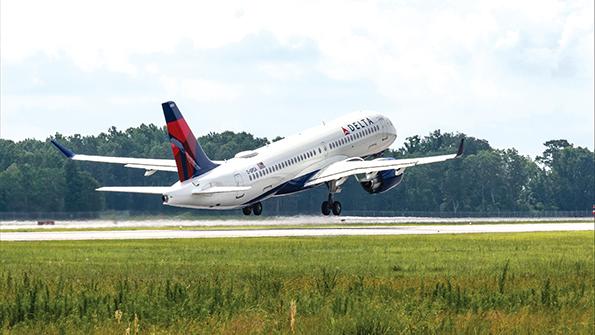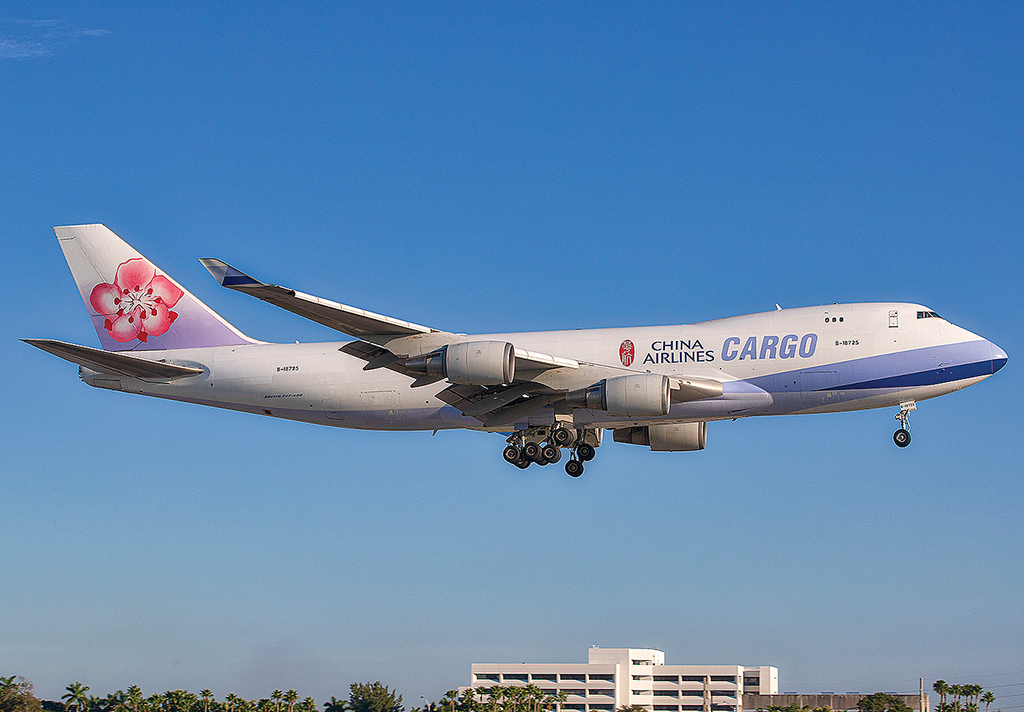
Airbus A220s need radio altimeter upgrades to fly in 5G environments.
An FAA proposal to codify an already agreed-upon plan that calls for commercial operators to upgrade radio altimeters to ensure aircraft can operate safely near new 5G C-band radio towers gives airlines an additional seven-month buffer to fortify their fleets. While some airlines are concerned that suppliers will not keep up with demand for needed equipment, the general consensus is that most affected operators will meet the proposed deadlines.
The FAA’s draft airworthiness directive (AD), published Jan. 11, lays out new radio, or radar altimeter (radalt), standards—expressed as an “effective isotropic power spectral density curve” relative to an aircraft’s height above ground and “received power from a 5G C-Band emitter”—for all U.S-registered transport and commuter-category aircraft. Those types of aircraft that do not meet the standards, or “tolerance requirements,” either need a filter or an upgraded radalt, or they risk facing operational restrictions. The AD also covers many multi-engine, fixed-wing business aircraft.
- Phased 5G rollout slated to hit major milestone July 1
- Aircraft with at-risk avionics face restrictions
- FAA confident that few issues will emerge
The proposed AD sets two deadlines. Most pressing is a June 30 date that requires all operators to meet the new tolerance requirements or face restrictions at 5G C-band mitigated airports (CMA). The CMAs are sites where wireless companies have agreed to mitigations, such as power reductions and specific antenna angles, to limit the chance of interference. For aircraft that do not meet the new standards, restrictions include no instrument landing system (ILS) approaches, “automatic landing options,” and limitations on head-up display and enhanced flight vision system usage at specific airports, the AD states.
The second deadline calls for U.S. Part 121 operators, or scheduled airlines, to ensure their aircraft have radalts that meet the new requirements by Feb. 1, 2024. This provides a seven-month grace period that would permit U.S. operators to upgrade any laggards in their fleet while keeping them away from known C-band areas.
Meeting the first deadline will ensure operators are prepared to fly into the CMAs—183 airports as of late January—under the mitigations wireless companies agreed to put in place. But as more wireless companies roll out services around the U.S., the FAA will drop the airport-by-airport evaluations and consider all U.S. airspace as a 5G environment. The second deadline reflects this reality.
While the proposed directive does not mandate retrofits for non-U.S. operators, the flight restrictions would apply universally. This creates a de facto mandate for all operators that use U.S. airspace.
The June 30 deadline aligns with a one-year voluntary extension of mitigations put in place by wireless providers AT&T and Verizon Wireless, two of more than 20 companies that plan to deploy midband 5G services. The one-year period was broken into quarters. At the end of each quarter, the companies activated new 5G towers and turned up the power on others that voluntarily were kept at lower outputs.
The FAA tailored a matching radalt upgrade schedule, ensuring the most vulnerable aircraft/radalt combinations were modified in advance of each quarterly 5G power-up.
Under the FAA’s plan, the upgrades should cover all but a handful of air carrier aircraft in so-called Group 4. In other words, most aircraft would be safe to operate in a 5G midband environment by July 1.
“We’ve made it clear to all the stakeholders that we’re committed to holding this timeline,” an FAA spokesperson says. “The agency has been working closely with all stakeholders to identify and address supply chain issues that might threaten the schedule.”
The agency declined to discuss specific tactics it may use to help bridge any remaining compliance gaps, citing the directive’s pending status and still unanswered questions about what, if any, issues will need addressing.
Several operators have told the FAA that supply chain bottlenecks will keep them from meeting the July deadline.
China Airlines told the agency it signed an agreement with an unnamed supplier in November. On Jan. 11, the supplier reported that “due to [a] parts shortage,” it cannot deliver needed equipment for the carrier’s Boeing 777 and 747-400 freighters by the FAA’s proposed deadlines.

“We can’t control the supply chain issue,” the carrier told the FAA in comments on the notice of proposed rulemaking, asking the agency to consider extending the deadlines or providing case-by-case alternate methods of compliance for affected aircraft.
SkyWest Airlines says it cannot equip its Embraer 175 and Bombardier CRJ fleets by late June, citing constraints on maintenance capacity and suppliers’ inability to provide filters fast enough.
“FiveG filters for SkyWest’s CRJ fleet are projected to begin arriving no sooner than March 2023,” the airline told the FAA. “This expected date only allows a brief four months to install the filters, which places an extreme burden on our maintenance personnel. Additionally, this scenario does not allow for any extenuating circumstances, namely a delay in 5G filter shipments or smaller than expected allotments.”
The radalt upgrades present various levels of complexity for operators and suppliers. Adding a filter usually involves complex wiring and mounting—work that can lead to multiday downtimes for affected aircraft. Queue up enough at a given carrier, and the maintenance burden quickly grows. Repeat the process at multiple carriers, and suppliers are strained to meet parts demand.
Whether the agency will show leniency related to operators’ constraints on maintenance capacity remains to be seen. Technical problems affecting entire subfleets are more likely to get relief.
Three sources with knowledge of the issues say only a few radalt/aircraft combinations continue to pose problems. They include Airbus A380s and A220s as well as Boeing 777s with certain Thales altimeters. While none of the issues are seen as insurmountable, operators of several subfleets will not make the FAA’s deadlines. Airbus has asked for more time for some A380s, two sources with knowledge of the request tell Aviation Week.
Among the challenges is the lack of a uniform approach. The aircraft and radalt manufacturers are working directly with affected operators and reporting progress to the FAA. Some operators report supply chain issues, while others do not. The International Air Transport Association (IATA) argues that a top-down strategy is more prudent.
“We urge the FAA to develop a project plan that includes milestones agreed to by all involved in the retrofit implementation,” the association wrote in a Feb. 2 letter to FAA acting Administrator Billy Nolen seen by Aviation Week. “In order to inform that plan, the FAA should request that aircraft and radio altimeter manufacturers provide written reports on the status of the retrofits of carrier aircraft,” including progress on needed retrofit instructions and the number of affected aircraft that need work.
“The FAA should use that information to develop a project plan that identifies realistic time frames agreed to by all parties as well as means by which to address barriers to success,” IATA added.
Another concern is whether non-U.S. carriers will be able to comply with the deadlines. IATA repeatedly has warned that the push by U.S. operators to meet the deadlines—notably the February 2024 date that must be met to avoid grounding of any noncompliant aircraft—means suppliers could favor them over non-U.S. customers.
“At least one of the radalt manufacturers has publicly acknowledged what has long been recognized as a particular challenge for Part 129 [non-U.S.] carriers: Their priority is supplying the U.S. (Part 121) airlines,” IATA wrote in a November 2022 letter to the FAA. “We see no indication that this dynamic will change” before the deadlines.
The lack of a mandate that applies to non-U.S. operators could be another hinderance. Absent a specific non-U.S. carrier requirement with clear consequences, some airlines may struggle to obtain the resources needed for the upgrades.
In use for years, radalts determine an aircraft’s absolute altitude by measuring the time it takes electromagnetic waves to travel from the aircraft to the surface below and back. The data play a central role in low-visibility operations and support key automated functions, such as traffic alert and collision avoidance systems (TCAS), enhanced ground proximity warning systems and automatic braking.
Radalts use the radio spectrum’s 4.2-4.4-GHz frequency band. This is next to new 5G C-band or “midband” services licensed to use 3.7-3.98 GHz that began rolling out in the lower part of the band in early 2022.
Responding to concerns about possible radalt interference, the FAA put a series of airport-by-airport restrictions and aircraft/radalt exemptions in place. The wireless companies agreed to hold off on full deployments around airports, once scheduled for late 2021, until at least July 2023.
The FAA and aviation stakeholders used that time to study the issue (AW&ST Jan. 24-Feb. 6, 2022, p. 30). That work led to the phased radalt retrofit plan, which takes into account both lessons learned and the expected rollout of more 5G wireless services that are closer to the radalt’s 4.2-4.4-GHz spectrum.
“The FAA is now able to assess the 5G C-Band transmissions’ impact on aviation operations in a specific area, taking into account the particularities of the signal and the airport environment,” the agency says. The signal-in-space (SIS) analysis “includes a three-dimensional model for the runway safety zone and considers base station heights and terrain around the airport,” it notes.
Meanwhile, aircraft manufacturers and radalt suppliers—including Collins Aerospace, Honeywell and Thales—studied their equipment to determine how susceptible it is to 5G interference. That work, combined with the FAA’s SIS efforts, gave the agency confidence it could put together a phased retrofit plan that would keep most aircraft operating safely as wireless companies slowly roll out their new services.
The slow 5G rollout also gave the FAA more time to quantify potential safety risks caused by signal interference. The agency has received about 420 reports of radalt “anomalies” since the 5G rollout began in January 2022. All but about 100 had nothing to do with 5G, the agency determined. As for the rest, “the FAA has excluded other potential causes for the anomaly but could not rule out 5G C-Band interference as the potential source” of interference.
Among those 100 reports were “various flight deck effects” including erroneous alerts from a terrain avoidance and warning system, TCAS and landing gear warning system as well as flight deck displays showing inaccurate radalt values. While spurious alerts and warnings may not be as severe as an ILS approach relying on incorrect altitude data, the trend raised alarms at the FAA.
“The erroneous warnings increase flight crew workload as they try to ascertain the validity of the warning,” the FAA says. “Repeated determinations that the warning occurred in error will lead to flight crew desensitization to warnings from these safety systems. In other words, as the flight crew becomes more desensitized to erroneous warnings, they are less likely to react to an accurate warning, negating the safety benefits of the warning altogether and likely leading to a catastrophic incident.”
The new standards replace airport-by-airport limits contained in Notices to Air Missions (NOTAM).
“Given 5G C-Band signals are not expected to be temporary and that 5G signals will cover the contiguous U.S., NOTAMs are no longer the best means of communicating the location of the 5G C-Band environment,” the FAA says. “In addition, given the information gleaned over the past year, the FAA is now able to identify the conditions under which radio altimeters can be relied on to perform their intended function in the presence of a 5G C-Band environment.”

Comments